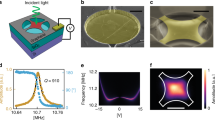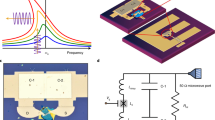Abstract
Sensitive microwave detectors are essential in radioastronomy1, dark-matter axion searches2 and superconducting quantum information science3,4. The conventional strategy to obtain higher-sensitivity bolometry is the nanofabrication of ever smaller devices to augment the thermal response5,6,7. However, it is difficult to obtain efficient photon coupling and to maintain the material properties in a device with a large surface-to-volume ratio owing to surface contamination. Here we present an ultimately thin bolometric sensor based on monolayer graphene. To utilize the minute electronic specific heat and thermal conductivity of graphene, we develop a superconductor–graphene–superconductor Josephson junction8,9,10,11,12,13 bolometer embedded in a microwave resonator with a resonance frequency of 7.9 gigahertz and over 99 per cent coupling efficiency. The dependence of the Josephson switching current on the operating temperature, charge density, input power and frequency shows a noise-equivalent power of 7 × 10−19 watts per square-root hertz, which corresponds to an energy resolution of a single 32-gigahertz photon14, reaching the fundamental limit imposed by intrinsic thermal fluctuations at 0.19 kelvin. Our results establish that two-dimensional materials could enable the development of bolometers with the highest sensitivity allowed by the laws of thermodynamics.
This is a preview of subscription content, access via your institution
Access options
Access Nature and 54 other Nature Portfolio journals
Get Nature+, our best-value online-access subscription
$29.99 / 30 days
cancel any time
Subscribe to this journal
Receive 51 print issues and online access
$199.00 per year
only $3.90 per issue
Buy this article
- Purchase on Springer Link
- Instant access to full article PDF
Prices may be subject to local taxes which are calculated during checkout




Similar content being viewed by others
Data availability
The data that support the findings of this study are available from the corresponding author upon reasonable request.
References
Benford, D., Amato, M., Mather, J. C., Moseley, S. H. & Leisawitz, D. Mission concept for the Single Aperture Far-Infrared (SAFIR) Observatory. Astrophys. Space Sci. 294, 177–212 (2004).
Graham, P. W., Irastorza, I. G., Lamoreaux, S. K., Lindner, A. & van Bibber, K. A. Experimental searches for the axion and axion-like particles. Annu. Rev. Nucl. Part. Sci. 65, 485–514 (2015).
Govia, L. C. G. et al. High-fidelity qubit measurement with a microwave-photon counter. Phys. Rev. A 90, 062307 (2014).
Inomata, K. et al. Single microwave-photon detector using an artificial Λ-type three-level system. Nat. Commun. 7, 12303 (2016).
Wei, J. et al. Ultrasensitive hot-electron nanobolometers for terahertz astrophysics. Nat. Nanotechnol. 3, 496–500 (2008).
Gasparinetti, S. et al. Fast electron thermometry for ultrasensitive calorimetric detection. Phys. Rev. Appl. 3, 014007 (2015).
Govenius, J., Lake, R. E., Tan, K. Y. & Möttönen, M. Detection of zeptojoule microwave pulses using electrothermal feedback in proximity-induced Josephson junctions. Phys. Rev. Lett. 117, 030802 (2016).
Lee, G.-H., Jeong, D., Choi, J.-H., Doh, Y.-J. & Lee, H.-J. Electrically tunable macroscopic quantum tunneling in a graphene-based Josephson junction. Phys. Rev. Lett. 107, 146605 (2011).
Coskun, U. C. et al. Distribution of supercurrent switching in graphene under the proximity effect. Phys. Rev. Lett. 108, 097003 (2012).
Borzenets, I., Coskun, U. C., Jones, S. J. & Finkelstein, G. Phonon bottleneck in graphene-based Josephson junctions at millikelvin temperatures. Phys. Rev. Lett. 111, 027001 (2013).
Calado, V. E. et al. Ballistic Josephson junctions in edge-contacted graphene. Nat. Nanotechnol. 10, 761–764 (2015).
Ben Shalom, M. et al. Quantum oscillations of the critical current and high-field superconducting proximity in ballistic graphene. Nat. Phys. 12, 318–322 (2016).
Wang, J. I.-J. et al. Coherent control of a hybrid superconducting circuit made with graphene-based van der Waals heterostructures. Nat. Nanotechnol. 14, 120–125 (2019).
Moseley, S. H., Mather, J. C. & McCammon, D. Thermal detectors as X-ray spectrometers. J. Appl. Phys. 56, 1257–1262 (1984).
Vora, H., Kumaravadivel, P., Nielsen, B. & Du, X. Bolometric response in graphene based superconducting tunnel junctions. Appl. Phys. Lett. 100, 153507 (2012).
Fong, K. C. & Schwab, K. Ultrasensitive and wide-bandwidth thermal measurements of graphene at low temperatures. Phys. Rev. X 2, 031006 (2012).
Yan, J. et al. Dual-gated bilayer graphene hot-electron bolometer. Nat. Nanotechnol. 7, 472–478 (2012).
McKitterick, C., Prober, D. & Karasik, B. Performance of graphene thermal photon detectors. J. Appl. Phys. 113, 044512 (2013).
Efetov, D. K. et al. Fast thermal relaxation in cavity-coupled graphene bolometers with a Johnson noise read-out. Nat. Nanotechnol. 13, 797–801 (2018).
Han, Q. et al. Highly sensitive hot electron bolometer based on disordered graphene. Sci. Rep. 3, 3533 (2013).
Cai, X. et al. Sensitive room-temperature terahertz detection via the photothermoelectric effect in graphene. Nat. Nanotechnol. 9, 814–819 (2014).
El Fatimy, A. E. et al. Epitaxial graphene quantum dots for high-performance terahertz bolometers. Nat. Nanotechnol. 11, 335–338 (2016).
Walsh, E. D. et al. Graphene-based Josephson-junction single-photon detector. Phys. Rev. Appl. 8, 024022 (2017).
Tielrooij, K. J. et al. Photoexcitation cascade and multiple hot-carrier generation in graphene. Nat. Phys. 9, 248–252 (2013).
Viljas, J. K. & Heikkila, T. T. Electron–phonon heat transfer in monolayer and bilayer graphene. Phys. Rev. B 81, 245404 (2010).
Song, J. C. W., Reizer, M. Y. & Levitov, L. S. Disorder-assisted electron–phonon scattering and cooling pathways in graphene. Phys. Rev. Lett. 109, 106602 (2012).
Chen, W. & Clerk, A. Electron-phonon mediated heat flow in disordered graphene. Phys. Rev. B 86, 125443 (2012).
Betz, A. C. et al. Supercollision cooling in undoped graphene. Nat. Phys. 9, 109–112 (2013).
Graham, M. W., Shi, S.-F., Ralph, D. C., Park, J. & Mceuen, P. L. Photocurrent measurements of supercollision cooling in graphene. Nat. Phys. 9, 103–108 (2013).
Tirelli, S. et al. Manipulation and generation of supercurrent in out-of-equilibrium Josephson tunnel nanojunctions. Phys. Rev. Lett. 101, 077004 (2008).
Morpurgo, A. F., Klapwijk, T. M. & van Wees, B. J. Hot electron tunable supercurrent. Appl. Phys. Lett. 72, 966–968 (1998).
Oelsner, G. et al. Detection of weak microwave fields with an underdamped Josephson junction. Phys. Rev. Appl. 7, 014012 (2017).
Draelos, A. W. et al. Supercurrent flow in multiterminal graphene Josephson junctions. Nano Lett. 19, 1039–1043 (2019).
Halbertal, D. et al. Imaging resonant dissipation from individual atomic defects in graphene. Science 358, 1303–1306 (2017).
Martinis, J. M., Devoret, M. H. & Clarke, J. Experimental tests for the quantum behavior of a macroscopic degree of freedom: the phase difference across a Josephson junction. Phys. Rev. B 35, 4682–4698 (1987).
Fulton, T. A. & Dunkelberger, L. N. Lifetime of zero-voltage state in Josephson tunnel junctions. Phys. Rev. B 9, 4760–4768 (1974).
Ponomarenko, L. A. et al. Cloning of Dirac fermions in graphene superlattices. Nature 497, 594–597 (2013).
Khalil, M. S., Stoutimore, M. J. A., Wellstood, F. C. & Osborn, K. D. An analysis method for asymmetric resonator transmission applied to superconducting devices. J. Appl. Phys. 111, 054510 (2012).
Kong, J. F., Levitov, L., Halbertal, D. & Zeldov, E. Resonant electron-lattice cooling in graphene. Phys. Rev. B 97, 245416 (2018).
Acknowledgements
We acknowledge discussions with L. Levitov, M.-H. Nguyen and W. Kalfus. We thank H.-J. Lee for fabrication facility support for some of the devices. W.J. and G.-H.L. acknowledge support from the Samsung Science and Technology Foundation under Project Number SSTFBA1702-05. D.K.E. acknowledges support from the Ministry of Economy and Competitiveness of Spain through the “Severo Ochoa” programme for Centres of Excellence in R&D (SE5-0522), Fundació Privada Cellex, Fundació Privada Mir-Puig, Generalitat de Catalunya through the CERCA programme, the H2020 Programme under grant agreement 820378 (project 2D⋅SIPC) and the La Caixa Foundation. The work of E.D.W. and D.E. was supported in part by the Army Research Laboratory Institute for Soldier Nanotechnologies programme W911NF-18-2-0048 and the US Army Research Laboratory (award W911NF-17-1-0435). K.W. and T.T. acknowledge support from the Elemental Strategy Initiative conducted by MEXT, Japan, grant number JPMXP0112101001, JSPS KAKENHI grant number JP20H00354 and CREST(JPMJCR15F3), JST. The work of P.K. and K.C.F. was supported by the US Army Research Office under Cooperative Agreement number W911NF-17-1-0574.
Author information
Authors and Affiliations
Contributions
G.-H.L., T.A.O., D.E. and K.C.F. conceived the project. L.R., G.-H.L. and W.J. designed and fabricated the samples. T.T. and K.W. provided the hBN crystal. G.-H.L., E.D.W. and K.C.F. performed the measurements. G.-H.L., D.K.E., L.R., E.D.W., T.A.O., P.K., D.E. and K.C.F. performed the data analysis and wrote the paper. P.K., D.E. and K.C.F. supervised the project.
Corresponding author
Ethics declarations
Competing interests
The authors declare no competing interests.
Additional information
Publisher’s note Springer Nature remains neutral with regard to jurisdictional claims in published maps and institutional affiliations.
Extended data figures and tables
Extended Data Fig. 1 Loaded Q factor of input resonator.
Fitting of the loaded quality factor of the microwave resonator. Shown is the phase of the S11 scattering parameter of the half-wave microwave resonator at two different gate voltages. Data from the same dataset as in Fig. 3a.
Extended Data Fig. 2 GJJ bolometer input resonator.
a, b, Suppression of the switching current at the resonance frequency of the input resonator for Device H (a) and Device T (b) with test power of −15 dBm applied outside the cryostat at 0.3 K (a) and 0.2 K (b). See Extended Data Table 1 for the dimensions and measured parameters of the devices.
Extended Data Fig. 3 GJJ switching current.
a, b, Average switching current of the Josephson junction for Device H (a) and Device T (b).
Extended Data Fig. 4 Electron cooling.
a, b, Interpolated graphene electron temperature versus input power for Device H with a carrier density of ~0.72 × 1012 cm−2 (a) and Device T with a carrier density of ~3.2 × 1012 cm−2 (b). The lines are fits using the electron–phonon heat transfer theory.
Rights and permissions
About this article
Cite this article
Lee, GH., Efetov, D.K., Jung, W. et al. Graphene-based Josephson junction microwave bolometer. Nature 586, 42–46 (2020). https://doi.org/10.1038/s41586-020-2752-4
Received:
Accepted:
Published:
Issue Date:
DOI: https://doi.org/10.1038/s41586-020-2752-4
This article is cited by
-
Josephson radiation threshold detector
Scientific Reports (2024)
-
Layered materials as a platform for quantum technologies
Nature Nanotechnology (2023)
-
Stack growth of wafer-scale van der Waals superconductor heterostructures
Nature (2023)
-
Electronic thermal transport measurement in low-dimensional materials with graphene non-local noise thermometry
Nature Nanotechnology (2022)
-
Effect of dilute impurities on short graphene Josephson junctions
Communications Physics (2022)
Comments
By submitting a comment you agree to abide by our Terms and Community Guidelines. If you find something abusive or that does not comply with our terms or guidelines please flag it as inappropriate.



